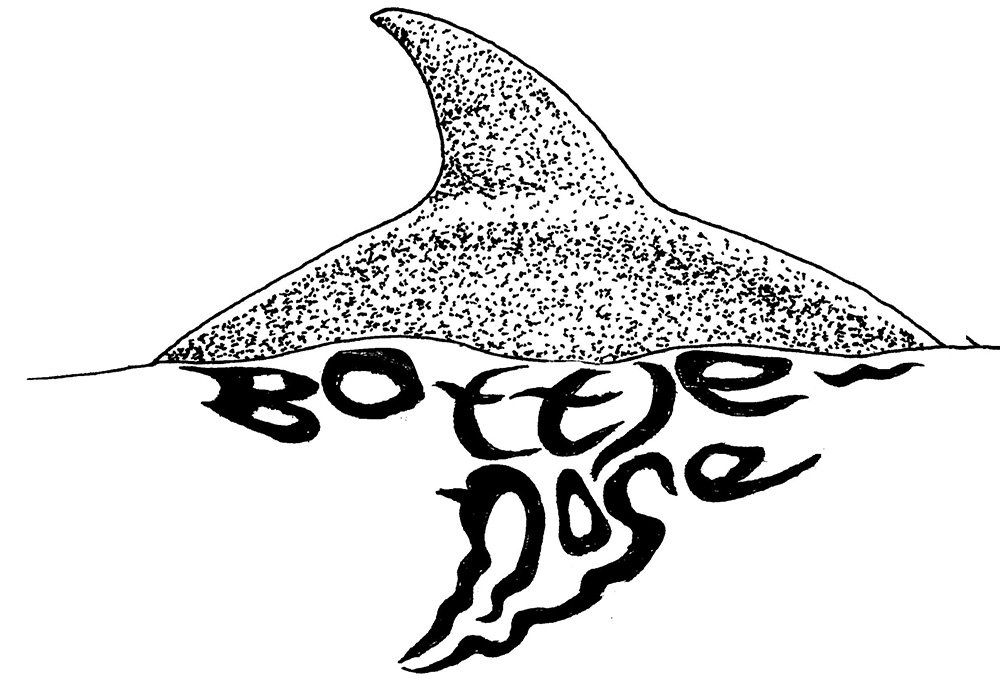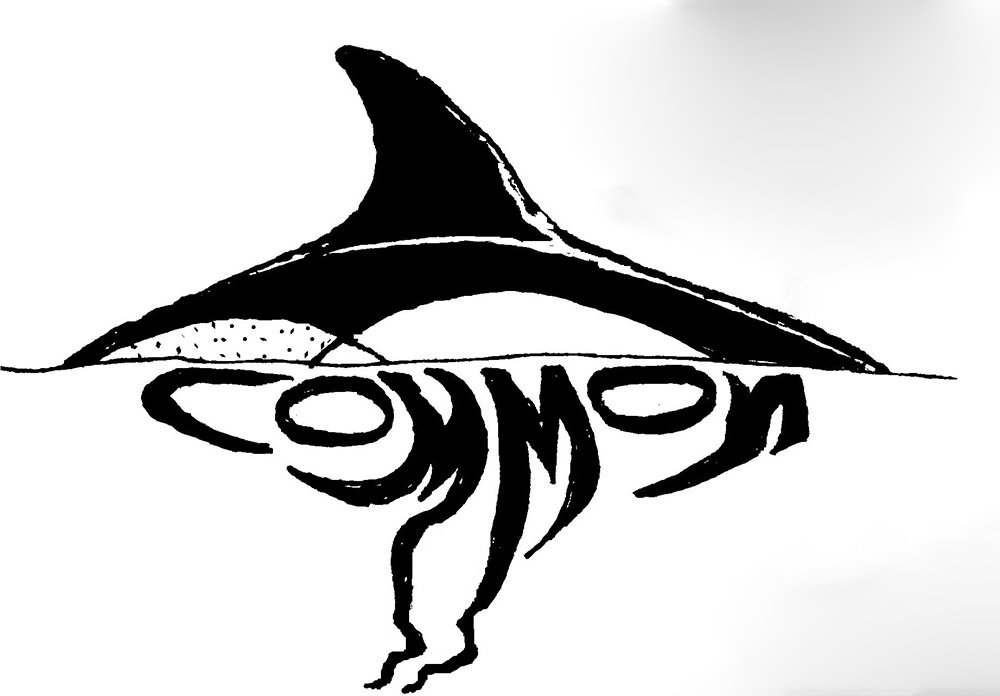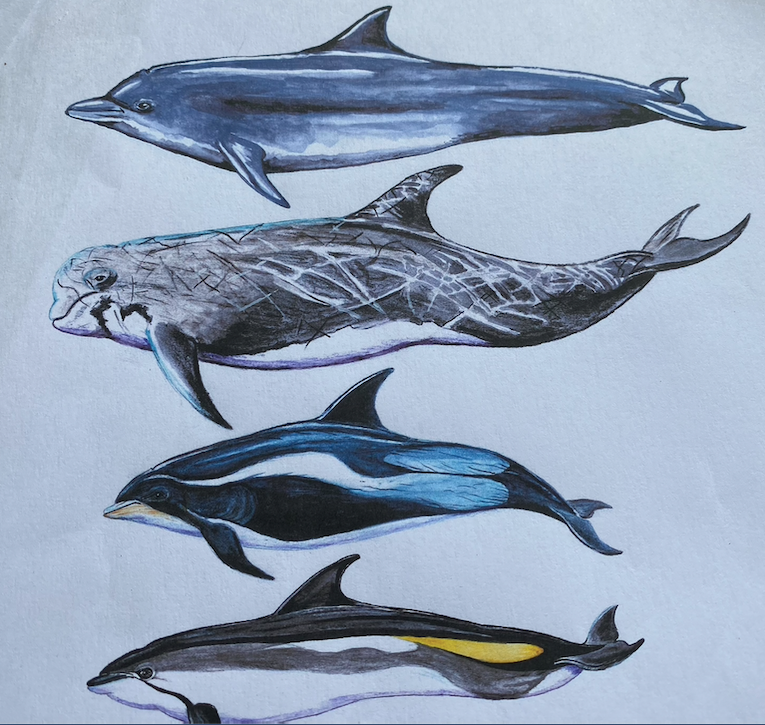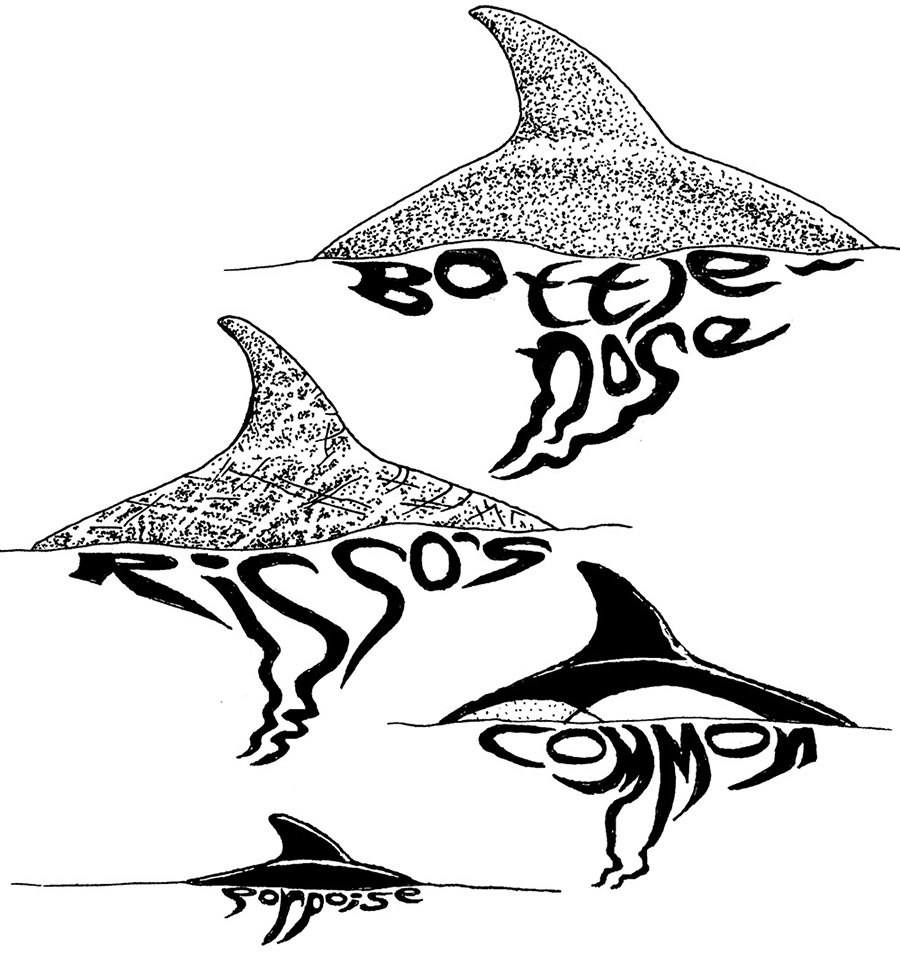Porpoisfully looking at Dol-Fins
When we’re lucky enough to see dolphins (or unidentified cetaceans), it’s not always easy to tell which species they are. Sometimes they leap clear or poke their heads out of the water but, more often than not, all we see is a dorsal fin and a bit of back with no head showing for long enough and no classic display of tail as they dive for the deep. Are dorsal fin and a bit of back enough to identify a species? Well, they may be. To get my head around it, I started drawing fins and backs.
Concentrating on our 4 commonest small(ish) cetaceans from largest to smallest here goes.
Bottlenose Dolphin
The bottlenose dolphin can be over 3 metres long (nearly 4 metres). Its fin and back are grey and, apart from getting paler towards the belly and chin there is very little visible pattern from a distance and what there is tends to be tones rather than colour change.

Risso’s Dolphin
The Risso’s dolphin is a similar size and rarer, and often associates with other dolphins. Like the bottlenose, it can rarely resist poking its head out of the water, when its blunt bottleless face with a crease from forehead to top lip will give it away. But, if it is only fin and a bit of back you see then the Risso’s, whilst grey like a bottlenose, tends to be covered in scratches. With a taller or more sickle shaped fin which is much more obvious if you have the 2 species conveniently together! Look for the scratches though… they ‘play’ rough.
Older animals can be white as the scratches seemingly fill in the whole body from the head backwards. It is less likely to approach or bow ride with boats than the bottlenose but more likely to follow from a distance and watch curiously. My limited experience of them in a Kayak is that they turn up from nowhere, from behind and do a ‘fly-past’ to satisfy themselves what you are and then keep their distance.

Common Dolphin
The common dolphin’s dorsal fin appears black. They are about half the size of the two species above measuring about 2.4 metres from nose to tail. They are energetic swimmers, often in large groups swimming purposefully and sooner or later a bit of flank will show. This may reveal a glimpse of sharpish V-shaped dip in the black pattern below the dorsal fin. If you could see more you would see that this shape is the central cross of the characteristic hour-glass shape on the dolphins side. That’s just about enough to identify it in British waters but, if you can see yellowish colouring forward of the dip then it is likely you are looking at a common dolphin.

Harbour Porpoise
The most common of our fab four, and partly because they are very coastal anyway, is the harbour porpoise. At just over one and a half metres it is the smallest too. Its fin is black and looks lower and blunter than any of the dolphins above; more of a wavelet than a roller if we compare them to waves in profile. Porpoises tend to keep low in the water and are easily missed. They are rarely energetic enough to show much flank so usually only black is visible. They’re usually not very interested in boats and often swim in higgledy piggledy fashion at angles to each other rather than uniformly in one direction as common dolphins tend to.

I’m no expert and the above may not quite get you to a positive identification, but should at least allow you to rule a couple of species out.
Rarer Species
Of the rarer smallish species, the only one I know of with a bit of yellow in its pattern is the white sided dolphin. This yellow may be subtle but, if visible will be behind the dorsal fin, not ahead of it and follows on from a stretch of white flank like a ‘go-faster’ sporty stripe. Above the stripe is black or very dark.
There’s no such white stripe in the white beaked dolphin which, as it ‘rolls’ to breath often reveals two white or pale patches, one fore and the other aft. The above two are slightly larger than the common dolphin whilst the striped or blue-white dolphin is slightly smaller. I am a terrible judge of size when looking out to sea and have never seen these rarer species in the wild.
My only experience of them is being called out to dead strandings when I worked in museums… fascinating but not pleasant. Anyway, the striped dolphin, whose fin and back may look black or blueish grey, may show enough flank to show the stripe which runs from the eye to the underside of the tail. If it doesn’t, you are still likely to see the ‘finger’ patterns below the dorsal fin; a pale finger points astern and a dark finger, less visible below it, points for’ard.
Knowing these things, makes me look a little harder and see a little more and hopefully it will help you too.

Celebrating Cetaceans
We love to celebrate cetaceans, we were lucky enough to have a blog written for us by Holly Dunn of the Sea Trust in Pembrokeshire all about their porpoise project. You can read that here >>>
We have a free dolphin fun pack that you can download here >>>
One of our first T-shirt designs was cetaceans, we have a small number left, you can find those here >>>
If you’d like a copy of the ID art you can grab a free copy here >>>

And watch this space for an all new dolphin ID poster coming soon.
References
Whilst I have a little experience, most of this information comes from Lyall Watson’s fabulous Whales of the World and Mark Carwardine’s Dorling Kindersley Whale Dolphins and porpoises with snippets gleaned from Corbet and Southern’s Handbook of British Mammals. There may now be better information available but I feel enriched by those 3 books.

